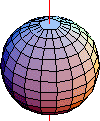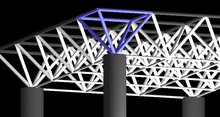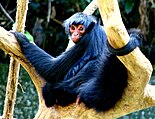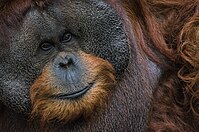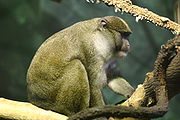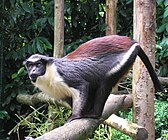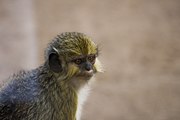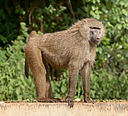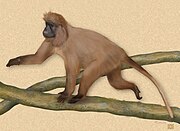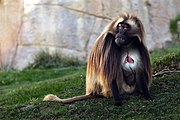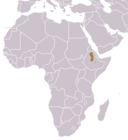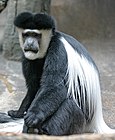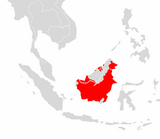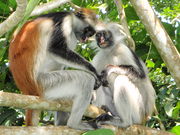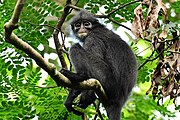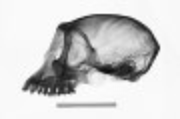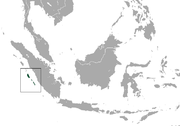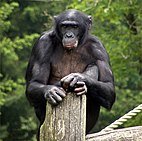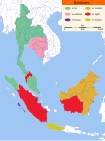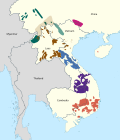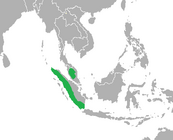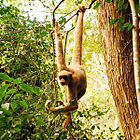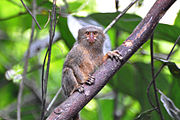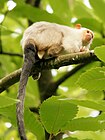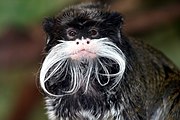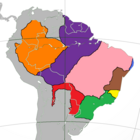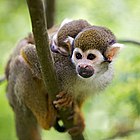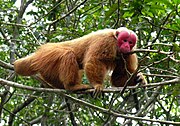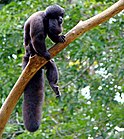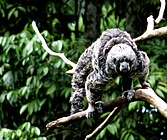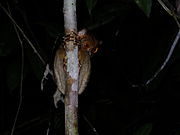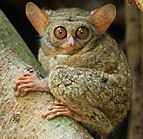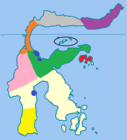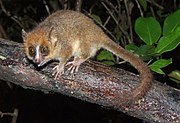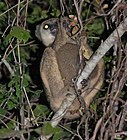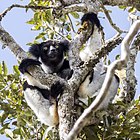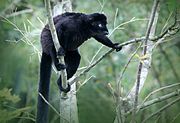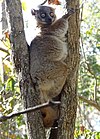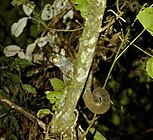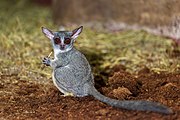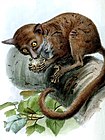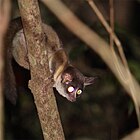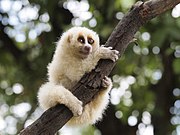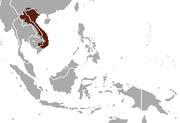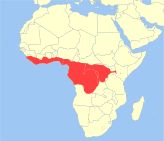List of primates
Animals in mammal order Primates
Range and density of non-human primates Primates is a diverse order of placental mammals which includes monkeys , lemurs , galagos , lorisids , tarsiers , and apes (including humans ). Members of this order are called primates. The order currently comprises 505 extant species, which are grouped into 81 genera . The majority of primates live in South and Central America, Africa, and southern and Southeast Asia, in a variety of habitats, particularly forests but also including grasslands, savannas, shrublands, wetlands, deserts, and rocky areas. The exception is humans, which have spread worldwide to every biome . Primates come in a variety of body plans but typically feature large brains, a shoulder girdle allowing a large degree of movement in the shoulder joint, dexterous hands, and tails, sometimes prehensile .[ 1] Margot Marsh's mouse lemur , at 8 cm (3 in) plus a 11 cm (4 in) tail, to the eastern gorilla , at 196 cm (77 in), not including limbs. Primates are also the most intelligent animals and non-human primates are recorded to use tools , communicate with gestures and vocalizations, and have complex social systems .[ 2]
Primates is divided into two suborders: Haplorrhini and Strepsirrhini . The suborders are further subdivided into clades and families . Haplorrhini contains nine families in four major clades: Cercopithecoidea , containing the Old World monkeys of the family Cercopithecidae ; Hominoidea , containing the great apes of the family Hominidae and the gibbons of the family Hylobatidae ; Platyrrhines , or New World monkeys, divided into the families Aotidae , Atelidae , Callitrichidae , Cebidae , and Pitheciidae and containing night, howler, spider, woolly, capuchin, squirrel, and saki monkeys, marmosets, and tamarins; and Tarsiiformes , containing the tarsier family Tarsiidae . Strepsirrhini is split between two clades: Lemuroidea , divided into the families Cheirogaleidae (dwarf and mouse lemurs), Daubentoniidae (the aye-aye), Indriidae (wooly lemurs, sifakas, and indri), Lemuridae (lemurs), and Lepilemuridae (sportive lemurs); and Lorisoidea , split between the galago family Galagidae and the loris family Lorisidae . The exact organization of the species is not fixed, with many recent proposals made based on molecular phylogenetic analysis . No species have been recorded as going extinct since 1500 CE, but over 200 species, or more than 40 percent of all primates, are considered endangered or critically endangered .
Conventions
Range maps are provided wherever possible; if a range map is not available, a description of the collective range of species in that genera is provided. Ranges are based on the International Union for Conservation of Nature (IUCN) Red List of Threatened Species unless otherwise noted.
Classification
The order Primates consists of 505 extant species belonging to 81 genera. This does not include hybrid species or extinct prehistoric species. Modern molecular studies indicate that the 81 genera can be grouped into 16 families ; these families are divided between two named suborders and are grouped in those suborders into named clades , and some of these families are subdivided into named subfamilies.
Suborder Haplorrhini
Superfamily Cercopithecoidea
Superfamily Hominoidea (apes)
Family Hominidae (hominids)
Subfamily Homininae (African hominids): 3 genera, 5 species
Subfamily Ponginae (Asian hominids): 1 genus, 3 species
Family Hylobatidae (gibbons): 4 genera, 20 species
Parvorder Platyrrhines (New World monkeys)
Family Aotidae (night monkeys): 1 genus, 11 species
Family Atelidae
Subfamily Alouattinae (howler monkeys): 1 genus, 12 species
Subfamily Atelinae (spider and wooly monkeys): 3 genera, 11 species
Family Callitrichidae (marmosets and tamarins): 7 genera, 43 species
Family Cebidae
Subfamily Cebinae (capuchin monkeys): 2 genera, 11 species
Subfamily Saimiriinae (squirrel monkeys): 1 genus, 7 species
Family Pitheciidae
Subfamily Callicebinae (titi monkeys): 3 genera, 33 species
Subfamily Pitheciinae (saki monkeys and uakaris: 3 genera, 25 species
Infraorder Tarsiiformes
Family Tarsiidae (tarsiers): 3 genera, 14 species Suborder Strepsirrhini
Primates
The following classification is based on the taxonomy described by Mammal Species of the World molecular phylogenetic analysis , as supported by both the IUCN and the American Society of Mammalogists .[ 4]
Suborder Haplorrhini
Superfamily Cercopithecoidea
Family Cercopithecidae
Members of the Cercopithecidae family are called cercopithecids, or colloquially Old World monkeys, and include baboons , colobuses , guenons , lutungs , macaques , and other types of monkeys . Cercopithecidae comprises 158 extant species, divided into 23 genera. These genera are grouped into two subfamilies: Cercopithecinae , or cercopithecine monkeys, containing baboon, guenon, macaque, and other monkey species; and Colobinae , or leaf-eating monkeys, containing colobus, lutung, and other monkey species.
Subfamily Cercopithecinae Gray , 1821
Name
Authority and species
Range
Size and ecology
Allenopithecus
Lang , 1923
Central Africa
Size : 33–51 cm (13–20 in) long, plus 35–52 cm (14–20 in) tail[ 5] Habitats : Forest[ 6] Diet : Fruit, leaves, and small invertebrates[ 7]
Allochrocebus
Elliot , 1913
Central and west-central Africa
Size range : 31–69 cm (12–27 in) long, plus 48–10 cm (19–4 in) tail (L'Hoest's monkey)[ 8] Habitats : Grassland and forest[ 9] Diets : Fruit, seeds, shoots, leaves, buds, flowers, mushrooms, and invertebrates[ 8]
Cercocebus
É Geoffroy , 1812
Equatorial Africa
Size range : 40–80 cm (16–31 in) long, plus 45–100 cm (18–39 in) tail (Golden-bellied mangabey)[ 10] Habitats : Inland wetlands, forest, shrubland, and savanna[ 10] Diets : Invertebrates, fruit, leaves, nuts, seeds, nectar, stems, roots, insects, fungi, grass, and small vertebrates[ 10]
Cercopithecus
Linnaeus , 1758
Sub-Saharan Africa
Size range : 29 cm (11 in) long, plus 57 cm (22 in) tail (Lesser spot-nosed monkey) to 70 cm (28 in) long, plus 109 cm (43 in) tail (Blue monkey)[ 11] Habitats : Inland wetlands, forest, shrubland, and savanna[ 11] Diets : Fruit, leaves, seeds, shoots, herbs, invertebrates, flowers, buds, tree gum, birds, bird eggs, and small reptiles[ 11]
Chlorocebus
Gray , 1870
Equatorial, eastern, and southern Africa
Size range : 34 cm (13 in) long, plus 44 cm (17 in) tail (Malbrouck) to 83 cm (33 in) long, plus 114 cm (45 in) tail (Tantalus monkey)[ 12] Habitats : Forest, shrubland, and savanna[ 13] Diets : Fruit, leaves, flowers, small vertebrates, shoots, stems, roots, insects, bark, gum, eggs, invertebrates, pith , seeds, and mushrooms[ 12]
Erythrocebus
Trouessart , 1897
Equatorial and Eastern Africa
Size range : 49 cm (19 in) long, plus 43 cm (17 in) tail (Blue Nile patas monkey) to 70 cm (28 in) long, plus 70 cm (28 in) tail (Common patas monkey)[ 14] Habitats : Grassland, forest, shrubland, and savanna[ 15] Diets : Fruit, insects, gum, and arthropods, as well as flowers, fruit, seeds, leaves, stems, roots, small vertebrates, and bird eggs[ 14]
Lophocebus
Palmer , 1903
Central Africa
Size range : 44–75 cm (17–30 in) long, plus 57–94 cm (22–37 in) tail (Grey-cheeked mangabey)[ 16] Habitats : Forest[ 16] Diets : Fruit and seeds[ 16]
Macaca
Lacépède , 1799
Southern, southeastern, and eastern Asia, and northwestern Africa
Size range : 36 cm (14 in) long, plus 36 cm (14 in) tail (Toque macaque) to 77 cm (30 in) long, plus 20 cm (8 in) tail (Arunachal macaque)[ 17] Habitats : Inland wetlands, rocky areas, shrubland, savanna, grassland, forest, intertidal marine, and caves[ 18] Diets : Fish, crabs, shellfish, bird eggs, honeycombs, invertebrates, gums, pith, seeds, leaves, flowers, dirt, fungi, and birds[ 17]
Mandrillus
Ritgen , 1824
Western Africa
Size range : 55–95 cm (22–37 in) long, plus 7–10 cm (3–4 in) tail (Mandrill)[ 19] Habitats : Rocky areas, forest, and savanna[ 19] Diets : Omnivorous, primarily fruit and seeds[ 19]
Miopithecus
Geoffroy , 1842
Western Africa
Size range : 23 cm (9 in) long, plus 31 cm (12 in) tail (Gabon talapoin) to 45 cm (18 in) long, plus 53 cm (21 in) tail (Angolan talapoin)[ 20] Habitats : Inland wetlands and forest[ 20] Diets : Insects, leaves, seeds, fruit, water plants, grubs, eggs, and small vertebrates[ 20]
Papio
Erxleben , 1777
Sub-Saharan Africa and southwestern Arabian Peninsula
Size range : 50–115 cm (20–45 in) long, plus 45–72 cm (18–28 in) tail (Chacma baboon)[ 21] Habitats : Inland wetlands, rocky areas, shrubland, savanna, desert, grassland, and forest[ 22] Diets : Fruit, leaves, roots, insects, eggs, small vertebrates, flowers, buds, grass, and seeds[ 21]
Rungwecebus
Davenport , 2006
Southeastern Africa
Size : 85–90 cm (33–35 in) long, plus about 115 cm (45 in) tail[ 23] Habitats : Forest[ 24] Diet : Omnivorous, including bulbs, roots, shoots, seeds, and fruit[ 23]
Theropithecus
Geoffroy , 1843
Eastern Africa
Size : 50–75 cm (20–30 in) long, plus 32–55 cm (13–22 in) tail[ 25] Habitats : Grassland and rocky areas[ 26] Diet : Leaves and forbs , as well as roots, corms , tubers and rhizomes [ 26]
Subfamily Colobinae Jerdon , 1867
Name
Authority and species
Range
Size and ecology
Colobus
Illiger , 1811
Central Africa and Western Africa
Size range : 45–72 cm (18–28 in) long, plus 52–100 cm (20–39 in) tail (King colobus)[ 27] Habitats : Forest and savanna[ 28] Diets : Leaves, nuts, and seeds, as well as fruit, flowers, buds, stems, bark, shoots, insects, and clay[ 27]
Nasalis
É Geoffroy , 1812
Borneo
Size : 61–76 cm (24–30 in) long, plus 50–75 cm (20–30 in) tail[ 29] Habitats : Forest[ 30] Diet : Fruit, seeds, leaves, and shoots, as well as caterpillars and larvae[ 31]
Piliocolobus
Rochebrune , 1887
Congo , and eastern and western Africa
Size range : 41–70 cm (16–28 in) long, plus 42–80 cm (17–31 in) tail (multiple)[ 32] Habitats : Inland wetlands, forest, shrubland, and savanna[ 33] Diets : Leaves, fruit, shoots, buds, flowers, and seeds, as well as flowers[ 32]
Presbytis
Eschscholtz , 1821
Southeastern Asia
Size range : 42 cm (17 in) long, plus 50 cm (20 in) tail (Black Sumatran langur) to 62 cm (24 in) long, plus 85 cm (33 in) tail (Thomas's langur)[ 34] Habitats : Inland wetlands, forest, and shrubland[ 35] Diets : Fruit, leaves, seeds and flowers, as well as bark, twigs, stalks, birds, bird eggs, algae, and insects[ 34]
Procolobus
Rochebrune , 1877
Western Africa
Size : 43–50 cm (17–20 in) long, plus 57–64 cm (22–25 in) tail[ 36] Habitats : Forest[ 37] Diet : Leaves and flowers[ 38]
Pygathrix
É Geoffroy , 1812
Southeastern Asia
Size range : 60 cm (24 in) long, plus 56 cm (22 in) tail (Black-shanked douc) to 77 cm (30 in) long, plus 77 cm (30 in) tail (Red-shanked douc)[ 39] Habitats : Forest[ 39] Diets : Leaves, as well as fruit, seeds, buds, and flowers[ 39]
Rhinopithecus
H. Milne-Edwards , 1872
Southern China, Central China, Northern Vietnam, and Northern Myanmar
Size range : 51 cm (20 in) long, plus 66 cm (26 in) tail (Tonkin snub-nosed monkey) to 83 cm (33 in) long, plus 72 cm (28 in) tail (Black-and-white snub-nosed monkey)[ 40] Habitats : Forest[ 41] Diets : Leaves, fruit, buds, flowers, buds, bark, seeds, and lichen, as well as insect larvae[ 40]
Semnopithecus
Desmarest , 1822
Sri Lanka, India, and Himalayas
Size range : 41–78 cm (16–31 in) long, plus 69–108 cm (27–43 in) (multiple)[ 42] Habitats : Rocky areas, forest, shrubland, and savanna[ 42] Diets : Leaves, fruit, and flowers, seeds, roots, bark, twigs, coniferous cones, moss, lichens, ferns, shoots, rhizomes, grass, and invertebrates[ 42]
Simias
Miller , 1903
Islands near Sumatra in Indonesia
Size : 45–53 cm (18–21 in) long, plus 13–18 cm (5–7 in) tail[ 43] Habitats : Forest[ 44] Diet : Leaves, fruit, and berries[ 45]
Trachypithecus
Reichenbach , 1862
Southeastern Asia
Size range : 40–76 cm (16–30 in) long, plus 57–110 cm (22–43 in) tail (multiple)[ 46] Habitats : Inland wetlands, rocky areas, forests, forest, and caves[ 47] Diets : Leaves, flowers, fruit, shoots, seeds, and twigs, as well as bark and insects[ 46]
Superfamily Hominoidea
Family Hominidae
Members of the Hominidae family are hominids, or colloquially great apes, and include gorillas , chimpanzees , orangutans , and humans . Hominoidae comprises eight extant species, divided into four genera. These genera are grouped into two subfamilies: Homininae , or African hominids, containing gorillas, chimpanzees, bonobos , and humans; and Ponginae , or Asian hominids, containing orangutans.
Subfamily Homininae Gray , 1825
Name
Authority and species
Range
Size and ecology
Gorilla
Geoffroy , 1852
Central Africa and Western Africa
Size range : 130 cm (51 in) long (Western gorilla) to 196 cm (77 in) long (Eastern gorilla)[ 48] Habitats : Forest[ 49] Diets : Leaves, berries, ferns, bark, roots, stems, and pith, as well as wood, flowers, fruit, fungi, galls , invertebrates, and gorilla dung[ 48]
Homo
Linnaeus , 1758
Worldwide (population density shown)
Size : 140–210 cm (55–83 in) long, including legs[ 50] Habitats : VariedDiet : Omnivorous
Pan
Oken , 1816
Central and western Africa
Size range : 63–90 cm (25–35 in) long (Chimpanzee)[ 51] Habitats : Forest and savanna[ 52] Diets : Fruit, leaves, stems, buds, bark, pith, seeds, and resins , as well as leaves, insects, shoots, small vertebrates, truffles, fungus, honey, and eggs[ 51]
Subfamily Ponginae Elliot , 1913
Name
Authority and species
Range
Size and ecology
Pongo
Lacépède , 1799
Borneo and Sumatra
Size range : 78–97 cm (31–38 in) long (Bornean orangutan)[ 53] Habitats : Forest[ 54] Diets : Fruit, leaves, shoots, flowers, and bark, as well as insects, sap, vines, spider webs, bird eggs, fungi, flowers, bark, and soil[ 53]
Family Hylobatidae
Members of the Hylobatidae family are hylobatids, or colloquially gibbons . Hylobatidae comprises 19 extant species, divided into four genera.
Not assigned to a named subfamily – four genera
Name
Authority and species
Range
Size and ecology
Hoolock
Mootnick & Groves , 2005
Southern Asia (in green)
Size range : 45 cm (18 in) long (Western hoolock gibbon) to 81 cm (32 in) long (Skywalker hoolock gibbon)[ 55] Habitats : Forest[ 55] Diets : Fruit and leaves, as well as shoots, invertebrates, bird chicks, and flowers[ 55]
Hylobates
Illiger , 1811
Southeastern Asia
Size range : 42 cm (17 in) long (Silvery gibbon) to 65 cm (26 in) long (Agile gibbon)[ 56] Habitats : Forest[ 56] Diets : Fruit, flowers, leaves, and insects, as well as eggs and small vertebrates[ 56]
Nomascus
Miller , 1933
Southeastern Asia
Size range : 40 cm (16 in) long (Eastern black crested gibbon) to 64 cm (25 in) long (Southern white-cheeked gibbon)[ 57] Habitats : Forest[ 57] Diets : Fruit, leaves, buds, shoots, and flowers, as well as insects, eggs, and small vertebrates[ 57]
Symphalangus
Gloger , 1841
Southeastern Asia
Size : 71–90 cm (28–35 in) long[ 58] Habitats : Forest[ 59] Diet : Fruit and leaves, as well as flowers and insects[ 59]
Parvorder Platyrrhines
Family Aotidae
Members of the Aotidae family are aotids, or colloquially night monkeys. Aotidae comprises eleven extant species in a single genus.
Not assigned to a named subfamily – one genus
Name
Authority and species
Range
Size and ecology
Aotus
Illiger , 1811
Central and northern South America and Central America
Size range : 24 cm (9 in) long, plus 31 cm (12 in) tail (Azara's night monkey) to 47 cm (19 in) long plus 42 cm (17 in) tail (Three-striped night monkey)[ 60] Habitats : Forest and savanna[ 60] Diets : Fruit, nectar, leaves, flowers, buds, and insects, as well as small vertebrates and eggs[ 60]
Family Atelidae
Members of the Atelidae family are atelids, or colloquially night monkeys, and include howler , spider , woolly , and woolly spider monkeys . Aotidae comprises 24 extant species in 4 genera. It is divided into the subfamilies Alouattinae , or howler monkeys, and Atelinae , or spider and woolly monkeys.
Subfamily Alouattinae Trouessart , 1897
Name
Authority and species
Range
Size and ecology
Alouatta
Lacépède , 1799
Mexico, Central America, and northern, eastern, and central South America
Size range : 38 cm (15 in) long, plus 52 cm (20 in) tail (Mantled howler) to 92 cm (36 in) long plus 92 cm (36 in) tail (Brown howler)[ 61] Habitats : Forest and savanna[ 61] Diets : Leaves, flowers, fruit, bark, and twigs as well as buds, seeds, moss, stems, termite nests, and decaying wood[ 61]
Subfamily Atelinae Gray , 1825
Name
Authority and species
Range
Size and ecology
Ateles
É Geoffroy , 1806
Mexico, Central America, and northern and central South America
Size range : 30–63 cm (12–25 in) long, plus 63–84 cm (25–33 in) tail (Geoffroy's spider monkey)[ 62] Habitats : Forest[ 63] Diets : Fruit, leaves, flowers, nuts, seeds, and insects, as well as bark, honey, decaying wood, roots, fungi, arachnids, and eggs[ 62]
Brachyteles
É Geoffroy , 1806
Southeastern Brazil
Size range : 46–50 cm (18–20 in) long, plus 72–81 cm (28–32 in) tail (both species)[ 64] Habitats : Forest[ 65] Diets : Leaves, fruit, vines, flowers, bark, nectar, and seeds[ 64]
Lagothrix
É Geoffroy , 1812
Western South America
Size range : 44 cm (17 in) long, plus 60 cm (24 in) tail (Yellow-tailed woolly monkey) to 69 cm (27 in) long plus 72 cm (28 in) tail (Common woolly monkey)[ 66] Habitats : Forest and savanna[ 67] Diets : Fruit, leaves, insects, seeds, moss, buds, and flowers[ 66]
Family Callitrichidae
Members of the Callitrichidae family are callitrichids, and include marmosets , tamarins , and lion tamarins . Callitrichidae comprises 43 extant species in 7 genera.
Not assigned to a named subfamily – seven genera
Name
Authority and species
Range
Size and ecology
Callimico
Miranda-Ribeiro , 1922
Western South America
Size : 21–23 cm (8–9 in) long, plus 25–33 cm (10–13 in) tail[ 68] Habitats : Forest[ 69] Diet : Fruit, insects, and fungi, as well as lizards, frogs, and other small vertebrates[ 68]
Callithrix
Erxleben , 1777
Eastern South America
Size range : 12 cm (5 in) long, plus 29 cm (11 in) tail (Common marmoset) to 30 cm (12 in) long plus 41 cm (16 in) tail (Buffy-headed marmoset)[ 70] Habitats : Forest and savanna[ 71] Diets : Plant gum, sap, fruit, flowers, nectar, seeds, insects, and spiders, as well as molluscs, small vertebrates, and bird eggs[ 70]
Cebuella
Gray , 1866
Western South America
Size range : 12 cm (5 in) long, plus 17 cm (7 in) tail (Western pygmy marmoset) to 30 cm (12 in) long plus 41 cm (16 in) tail (Eastern pygmy marmoset)[ 72] Habitats : Forest[ 73] Diets : Tree gum, sap, and resin, as well as insects, small lizards, fruit, flowers, and spiders[ 72]
Leontocebus
Wagner , 1840
Central and western South America
Size range : 17–31 cm (7–12 in) long, plus 25–44 cm (10–17 in) tail (multiple)[ 74] Habitats : Forest[ 74] Diets : Fruit, sap, nectar, vegetation, invertebrates, small vertebrates, and eggs[ 74]
Leontopithecus
Lesson , 1840
Southeastern South America
Size range : 20 cm (8 in) long, plus 31 cm (12 in) tail (Black lion tamarin) to 37 cm (15 in) long plus 40 cm (16 in) tail (Golden lion tamarin)[ 75] Habitats : Forest[ 76] Diets : Spiders, snails, insects, small lizards, eggs, small birds, fruit, flowers, gum, nectar, and vegetables, as well as snakes and other small vertebrates[ 75]
Mico
Lesson , 1840
Central South America
Size range : 18–30 cm (7–12 in) long, plus 17–41 cm (7–16 in) tail (multiple)[ 77] Habitats : Forest, shrubland, and savanna[ 77] Diets : Sap, gum, fruit, seeds, nuts, insects, snails, spiders, leaves and small vertebrates[ 77]
Saguinus
Hoffmannsegg , 1807
Western, central, and eastern South America and southeastern Central America
Size range : 17–31 cm (7–12 in) long, plus 25–44 cm (10–17 in) tail (multiple)[ 78] Habitats : Forest and savanna[ 78] Diets : Fruit, sap, nectar, gum, seeds, flowers, invertebrates, small vertebrates, eggs, and soil[ 78]
Family Cebidae
Members of the Cebidae family are cebids, and include capuchin and squirrel monkeys . Cebidae comprises eighteen extant species in three genera, and is divided into the subfamilies Cebinae , or capuchin monkeys, and Saimiriinae , or squirrel monkeys.
Subfamily Cebinae Bonaparte , 1831
Name
Authority and species
Range
Size and ecology
Cebus
Erxleben , 1777
Northern and central South America and southeastern Central America
Size range : 30–57 cm (12–22 in) long, plus 30–56 cm (12–22 in) tail (Kaapori capuchin)[ 79] Habitats : Forest and savanna[ 80] Diets : Fruit, seeds, berries, nuts, figs, nectar, invertebrates, and small vertebrates[ 79]
Sapajus
Kerr , 1792
Northern, central, and eastern South America
Size range : 30–57 cm (12–22 in) long, plus 30–56 cm (12–22 in) tail (multiple)[ 81] Habitats : Forest, shrubland, and savanna[ 81] Diets : Fruit, seeds, nectar, pith, stems, nuts, berries, flowers, leaves, bird eggs, insects, frogs, small reptiles, birds, bats, other small mammals, oysters, and crabs[ 81]
Subfamily Saimiriinae Miller , 1912
Name
Authority and species
Range
Size and ecology
Saimiri
Voigt , 1831
Northern and central South America and southern Central America
Size range : 22 cm (9 in) long, plus 37 cm (15 in) tail (Central American squirrel monkey) to 36 cm (14 in) long plus 43 cm (17 in) tail (Bare-eared squirrel monkey)[ 82] Habitats : Forest[ 82] Diets : Fruit, berries, seeds, nuts, gum, nectar, leaves, buds, flowers, insects, arachnids, bird eggs, and small vertebrates[ 82]
Family Pitheciidae
Members of the Pitheciidae family are pitheciids, and include titis , saki monkeys and uakaris . Pitheciidae comprises 55 extant species in 5 genera, and is divided into the subfamilies Callicebinae , or titis, and Pitheciinae , or saki monkeys and uakaris.
Subfamily Callicebinae Pocock , 1925
Name
Authority and species
Range
Size and ecology
Callicebus
Thomas , 1903
Eastern South America
Size range : 23–46 cm (9–18 in) long, plus 26–56 cm (10–22 in) tail (multiple)[ 83] Habitats : Forest, shrubland, and savanna[ 83] Diets : Fruit, leaves, flowers, seeds, and insects, as well as birds, vegetation, eggs, and small vertebrates and invertebrates[ 83]
Cheracebus
Byrne et al., 2016
Northern South America, Central South America, and Northwestern South America
Size range : 23–46 cm (9–18 in) long, plus 26–56 cm (10–22 in) tail (multiple)[ 84] Habitats : Forest and savanna[ 84] Diets : Fruit, seeds, leaves, stems, flowers, insects, spiders, and bird eggs[ 84]
Plecturocebus
Byrne et al., 2016
Northern, western, and central South America
Size range : 23–46 cm (9–18 in) long, plus 26–56 cm (10–22 in) tail (multiple)[ 85] Habitats : Forest and savanna[ 85] Diets : Fruit, flowers, seeds, leaves, vines, and insects, as well as arthropods, stems, shoots, eggs, and small vertebrates[ 85]
Subfamily Pitheciinae Mivart , 1865
Name
Authority and species
Range
Size and ecology
Cacajao
Lesson , 1840
Northern and western South America
Size range : 30–57 cm (12–22 in) long, plus 12–21 cm (5–8 in) tail (Aracá uakari)[ 86] Habitats : Forest and savanna[ 87] Diets : Fruit, nuts, seeds, flowers, leaves, nectar, insects, and arthropods[ 86]
Chiropotes
Lesson , 1840
Northern, northeastern, and central South America
Size range : 32 cm (13 in) long, plus 37 cm (15 in) tail (Black bearded saki) to 52 cm (20 in) long plus 51 cm (20 in) tail (Reddish-brown bearded saki)[ 88] Habitats : Forest[ 89] Diets : Fruit, seeds, nuts, flowers, and insects, as well as stems, arthropods, and leaves[ 88]
Pithecia
Desmarest , 1804
Northern and central South America
Size range : 20 cm (8 in) long, plus 20 cm (8 in) tail (Napo saki) to 71 cm (28 in) long plus 55 cm (22 in) tail (Burnished saki)[ 90] Habitats : Forest[ 90] Diets : Seeds, fruit pulp, leaves, insects, and flowers[ 90]
Family Tarsiidae
Members of the Tarsiidae family are tarsiids, or colloquially tarsiers. Tarsiidae comprises fourteen extant species in three genera.
Not assigned to a named subfamily – three genera
Name
Authority and species
Range
Size and ecology
Carlito
Groves & Shekelle , 2010
Southeastern Philippines
Size : 8–16 cm (3–6 in) long, plus about 25 cm (10 in) tail[ 91] Habitats : Forest[ 92] Diet : Insects, spiders, lizards, and other small vertebrates[ 91]
Cephalopachus
Swainson , 1835
Western Philippines
Size : 11–15 cm (4–6 in) long, plus 20–24 cm (8–9 in) tail[ 93] Habitats : Forest[ 94] Diet : Insects, as well as small vertebrates including birds, mammals, and reptiles[ 95]
Tarsius
Storr , 1780
Sulawesi , Indonesia Size range : 8 cm (3 in) long, plus 20 cm (8 in) tail (Pygmy tarsier) to 15 cm (6 in) long plus 20 cm (8 in) tail (Siau Island tarsier)[ 96] Habitats : Inland wetlands, forest, and caves[ 96] Diets : Arthropods and insects, as well as small vertebrates[ 96]
Suborder Strepsirrhini
Superfamily Lemuroidea
Family Cheirogaleidae
Members of the Cheirogaleidae family are cheirogaleids, and include dwarf , mouse , giant mouse , and fork-marked lemurs . Cheirogaleidae comprises 41 extant species in 5 genera.
Not assigned to a named subfamily – five genera
Name
Authority and species
Range
Size and ecology
Allocebus
Petter-Rousseaux & Petter , 1967
Northeastern Madagascar
Size : 12–15 cm (5–6 in) long, plus about 17 cm (7 in) tail[ 97] Habitats : Forest[ 98] Diet : Nectar, fruit, gum, leaves, honey, and insects[ 98]
Cheirogaleus
É Geoffroy , 1812
Madagascar
Size range : 16 cm (6 in) long, plus 18 cm (7 in) tail (Ankarana dwarf lemur) to 27 cm (11 in) long plus 31 cm (12 in) tail (Greater dwarf lemur)[ 99] Habitats : Forest and shrubland[ 99] Diets : Fruit, flowers, leaves, seeds, nectar, and insects, as well as small vertebrates and honey[ 99]
Microcebus
É Geoffroy , 1834
Madagascar
Size range : 8 cm (3 in) long, plus 11 cm (4 in) tail (Margot Marsh's mouse lemur) to 16 cm (6 in) long plus 15 cm (6 in) tail (Anosy mouse lemur)[ 100] Habitats : Forest and shrubland[ 100] Diets : Gum, insect excretions, nectar, fruit, leaves, flowers, pollen, arthropods, and small vertebrates[ 100]
Mirza
Gray , 1870
Western and northern Madagascar
Size range : 23 cm (9 in) long, plus 31 cm (12 in) tail (Coquerel's giant mouse lemur) to 27 cm (11 in) long plus 32 cm (13 in) tail (Coquerel's giant mouse lemur)[ 101] Habitats : Forest[ 101] Diets : Fruit, flowers, insect secretions, sap, and invertebrates, as well as small vertebrates[ 101]
Phaner
Gray , 1870
Western, northeastern, and northern Madagascar
Size range : 22–29 cm (9–11 in) long, plus 28–37 cm (11–15 in) tail (multiple)[ 102] Habitats : Forest[ 102] Diets : Sap and gum, as well as insects, insect secretions, fruit, flowers, and nectar[ 102]
Family Daubentoniidae
Members of the Daubentoniidae family are daubentoniids; the family comprises a single extant species, the aye-aye .
Not assigned to a named subfamily – one genus
Name
Authority and species
Range
Size and ecology
Daubentonia
É Geoffroy , 1795
Western and eastern Madagascar
Size : 36–44 cm (14–17 in) long, plus tail[ 103] Habitats : Forest and shrubland[ 104] Diet : Fruit, nuts, and sap[ 103]
Family Indriidae
Members of the Indriidae family are indriids, and include woolly lemurs , sifakas , and indri . Indriidae comprises nineteen extant species in three genera.
Not assigned to a named subfamily – three genera
Name
Authority and species
Range
Size and ecology
Avahi
Jourdan , 1834
Madagascar
Size range : 25 cm (10 in) long, plus 28 cm (11 in) tail (Betsileo woolly lemur) to 37 cm (15 in) long plus 35 cm (14 in) tail (Bemaraha woolly lemur)[ 105] Habitats : Forest[ 105] Diets : Buds and leaves, as well as flowers and fruit[ 105]
Indri
É. Geoffroy & G. Cuvier , 1796
Northeastern Madagascar
Size : 60–90 cm (24–35 in) long, plus 5–6 cm (2–2 in) tail[ 106] Habitats : Forest[ 107] Diet : Fruit, leaves, and flowers[ 106]
Propithecus
Bennett , 1832
Madagascar
Size range : 42 cm (17 in) long, plus 50 cm (20 in) tail (Coquerel's sifaka) to 55 cm (22 in) long, plus 56 cm (22 in) tail (Diademed sifaka)[ 108] Habitats : Forest, shrubland, and savanna[ 108] Diets : Leaves, flowers, fruit, seeds, shoots, and bark, as well as soil[ 108]
Family Lemuridae
Members of the Lemuridae family are lemurids, and include ring-tailed , true , ruffed , and bamboo lemurs . Indriidae comprises 21 extant species in 5 genera.
Not assigned to a named subfamily – five genera
Name
Authority and species
Range
Size and ecology
Eulemur
Simons & Rumpler , 1988
Madagascar
Size range : 30 cm (12 in) long, plus 40 cm (16 in) tail (Black lemur) to 51 cm (20 in) long plus 51 cm (20 in) tail (Common brown lemur)[ 109] Habitats : Forest[ 109] Diets : Leaves, fruit, buds, flowers, and pollen, as well as nectar, bark, insects, arthropods, fungi, and soil[ 109]
Hapalemur
Geoffroy , 1851
Western, northern, and eastern Madagascar
Size range : 24 cm (9 in) long, plus 32 cm (13 in) tail (Southern lesser bamboo lemur) to 34 cm (13 in) long plus 41 cm (16 in) tail (Golden bamboo lemur)[ 110] Habitats : Inland wetlands and forest[ 110] Diets : Marsh plants, bamboo, grass, pith, stems, flowers, and leaves, as well as fruit, fungi, and soil[ 110]
Lemur
Linnaeus , 1758
Southwestern Madagascar
Size : 39–46 cm (15–18 in) long, plus 56–63 cm (22–25 in) tail[ 111] Habitats : Forest, shrubland, rocky areas, and caves[ 112] Diet : Omnivorous, including fruit, leaves, stems, flowers, sap, spiders, spider webs, chameleons, insects, small birds, and termite mounds[ 111]
Prolemur
Gray , 1871
Eastern Madagascar
Size : 40–45 cm (16–18 in) long, plus 43–48 cm (17–19 in) tail[ 113] Habitats : Forest[ 114] Diet : Bamboo shoots and pith, as well as flowers, leaves, soil, and fruit[ 113]
Varecia
Gray , 1863
Eastern Madagascar
Size range : 45 cm (18 in) long, plus 60 cm (24 in) tail (Black-and-white ruffed lemur) to 50 cm (20 in) long plus 60 cm (24 in) tail (Red ruffed lemur)[ 115] Habitats : Forest[ 116] Diets : Fruit, nectar, and pollen, as well as leaves, flower, and seeds[ 115]
Family Lepilemuridae
Members of the Lepilemuridae family are lepilemurids, or colloquially sportive lemurs. Lepilemuridae comprises 25 extant species in a single genus.
Not assigned to a named subfamily – one genus
Name
Authority and species
Range
Size and ecology
Lepilemur
Geoffroy , 1851
Madagascar
Size range : 23 cm (9 in) long, plus 26 cm (10 in) tail (Gray-backed sportive lemur) to 41 cm (16 in) long plus 27 cm (11 in) tail (Hawks' sportive lemur)[ 117] Habitats : Forest[ 117] Diets : Leaves, vines, fruit, flowers, spiders, and insects, as well as seeds, pollen, latex , and bark[ 117]
Superfamily Lorisoidea
Family Galagidae
Members of the Galagidae family are galagids, or colloquially galagos or bush babies. Galagidae comprises nineteen extant species in six genera.
Not assigned to a named subfamily – six genera
Name
Authority and species
Range
Size and ecology
Euoticus
Gray , 1863
Western equatorial Africa
Size range : 18–33 cm (7–13 in) long, plus 28–31 cm (11–12 in) tail (Northern needle-clawed bushbaby)[ 118] Habitats : Forest[ 118] Diets : Tree gums and resins, as well as invertebrates[ 118]
Galago
É Geoffroy , 1796
Equatorial and southern Africa
Size range : 13–21 cm (5–8 in) long, plus 19–30 cm (7–12 in) tail (Senegal bushbaby)[ 119] Habitats : Forest and savanna[ 120] Diets : Invertebrates, fruit, flowers, and gum, as well as small birds, eggs, and seeds[ 119]
Galagoides
A. Smith , 1833
Western and central equatorial Africa
Size range : 10 cm (4 in) long, plus 15 cm (6 in) tail (Prince Demidoff's bushbaby) to 18 cm (7 in) long plus 21 cm (8 in) tail (Angolan dwarf galago)[ 121] Habitats : Forest and shrubland[ 122] Diets : Insects, as well as fruit, gum, small vertebrates, tree buds, and leaves[ 121]
Otolemur
Coquerel , 1859
Southern and eastern Africa
Size range : 23 cm (9 in) long, plus 36 cm (14 in) tail (Northern greater galago) to 38 cm (15 in) long plus 48 cm (19 in) tail (Brown greater galago)[ 123] Habitats : Forest, shrubland, and savanna[ 124] Diets : Gum, sap, fruit, and insects[ 123]
Paragalago
Masters , Génin , Couette , Groves , Nash , Delpero , & Pozzi , 2017
Southeastern Africa
Size range : 10 cm (4 in) long, plus 17 cm (7 in) tail (Rondo dwarf galago) to 19 cm (7 in) long plus 27 cm (11 in) tail (Grant's bushbaby)[ 125] Habitats : Forest[ 126] Diets : Fruit, gum, nectar, invertebrates, small vertebrates, and flowers[ 125]
Sciurocheirus
Waterhouse , 1838
Western equatorial Africa
Size range : 15–24 cm (6–9 in) long, plus 20–30 cm (8–12 in) tail (Bioko Allen's bushbaby)[ 127] Habitats : Forest[ 128] Diets : Arthropods, insects, fruit, and gum, as well as small mammals[ 127]
Family Lorisidae
Members of the Lorisidae family are lorisids, and include lorises , pottos and angwantibos . Lorisidae comprises sixteen extant species in five genera, and is divided into the subfamilies Lorisinae , or lorises, and Perodicticinae , or the angwantibos and pottos.
Subfamily Lorisinae Gray , 1821
Name
Authority and species
Range
Size and ecology
Loris
É Geoffroy , 1796
Sri Lanka and Southern India
Size range : 18 cm (7 in) long with no tail (Gray slender loris) to 26 cm (10 in) long with no tail (Red slender loris)[ 129] Habitats : Forest[ 130] Diets : Insects, as well as tree frogs, geckos, small birds, eggs, and fruit[ 129]
Nycticebus
É Geoffroy , 1812
Southeastern Asia (blue and brown)
Size range : 26 cm (10 in) long with no tail (Bangka slow loris) to 38 cm (15 in) long, with vestigial tail (Bengal slow loris)[ 131] Habitats : Forest[ 132] Diets : Resin, sap, gum, nectar, stems, fruit, invertebrates, lizards, bark, and bird eggs[ 131]
Xanthonycticebus
Nekaris & Nijman , 2022
Southeastern Asia
Size : 15–25 cm (6–10 in) long, with no tail[ 133] Habitats : Forest[ 134] Diet : Insects, gum, resin, fruit, and bamboo[ 133]
Subfamily Perodicticinae Gray , 1870
Name
Authority and species
Range
Size and ecology
Arctocebus
Gray , 1863
Western equatorial Africa
Size range : 22 cm (9 in) long, plus vestigial tail (Golden angwantibo) to 31 cm (12 in) long plus 10 cm (4 in) tail (Calabar angwantibo)[ 135] Habitats : Forest[ 136] Diets : Insects and fruit, as well as gum[ 135]
Perodicticus
Bennett , 1831
Western and central Africa
Size range : 29 cm (11 in) long, plus 4 cm (2 in) tail (East African potto) to 39 cm (15 in) long plus 10 cm (4 in) tail (West African potto)[ 137] Habitats : Forest[ 138] Diets : Fruit, gum, nectar, invertebrates, and eggs, as well as moss and small vertebrates[ 137]
References
^ Pough , ch. "Characteristics of Primates"^ Pough , pp. 269–289^ Cartmill; Smith p. 90^ Wilson, Reeder , pp. 114–184^ Kingdon 2015 , p. 143^ Maisels, F.; et al. (2020) [amended version of 2019 assessment]. "Allenopithecus nigroviridis " . IUCN Red List of Threatened Species 2020 : e.T865A166606573. doi :10.2305/IUCN.UK.2020-1.RLTS.T865A166606573.en ^ Sides, Corey (2023). "Allenopithecus nigroviridis " . Animal Diversity Web University of Michigan . Archived from the original on July 24, 2023. Retrieved July 24, 2023 . ^ a b Allochrocebus sizes and diets:
^ Allochrocebus habitats:
^ a b c Cercocebus sizes, habitats, and diets:
Agile mangabey :
Collared mangabey :
Golden-bellied mangabey :
Sanje mangabey :
Sooty mangabey :
Tana River mangabey :
White-naped mangabey :
^ a b c Cercopithecus sizes, habitats, and diets:
Blue monkey :
Campbell's mona monkey :
Crested mona monkey :
De Brazza's monkey :
Dent's mona monkey :
Diana monkey :
Greater spot-nosed monkey :
Hamlyn's monkey :
Lesser spot-nosed monkey :
Lesula :
Lowe's mona monkey :
Mona monkey :
Moustached guenon :
Red-eared guenon :
Red-tailed monkey :
Roloway monkey :
Sclater's guenon :
White-throated guenon :
Wolf's mona monkey :
^ a b Chlorocebus sizes and diets:
^ Chlorocebus habitats:
^ a b Erythrocebus sizes and diets:
^ Erythrocebus habitats:
^ a b c Lophocebus sizes, habitats, and diets:
Black crested mangabey :
Grey-cheeked mangabey :
^ a b Macaca sizes and diets:
Toque macaque :
Arunachal macaque , Assam macaque , Booted macaque , Gorontalo macaque , Heck's macaque , Moor macaque , Muna-Buton macaque , Pagai Island macaque , Tonkean macaque , White-cheeked macaque : Nowak 1999b , pp. 140, 142Barbary macaque : Jinn, Judy (2011). "Macaca sylvanus " . Animal Diversity Web University of Michigan . Archived from the original on July 24, 2023. Retrieved July 24, 2023 . Bonnet macaque :
Celebes crested macaque : Bichell, Rae Ellen (2011). "Macaca nigra " . Animal Diversity Web University of Michigan . Archived from the original on July 24, 2023. Retrieved July 24, 2023 . Crab-eating macaque :
Formosan rock macaque : Chiu, Crystal (2001). "Macaca cyclopis " . Animal Diversity Web University of Michigan . Archived from the original on August 30, 2023. Retrieved July 24, 2023 . Japanese macaque :
Lion-tailed macaque : Strawder, Nicole (2001). "Macaca silenus " . Animal Diversity Web University of Michigan . Archived from the original on August 12, 2023. Retrieved July 24, 2023 . Northern pig-tailed macaque :
Rhesus macaque :
Siberut macaque :
Southern pig-tailed macaque : Ayers, Kayla; et al. (2009). "Macaca nemestrina " . Animal Diversity Web University of Michigan . Archived from the original on April 15, 2023. Retrieved August 16, 2023 . Stump-tailed macaque : Erfurth, Charlotte (2008). "Macaca arctoides " . Animal Diversity Web University of Michigan . Archived from the original on July 24, 2023. Retrieved July 24, 2023 . Tibetan macaque :
^ Macaca habitats:
Toque macaque : Dittus, W.; et al. (2020). "Macaca sinica " . IUCN Red List of Threatened Species 2020 : e.T12560A17951229. doi :10.2305/IUCN.UK.2020-2.RLTS.T12560A17951229.en Arunachal macaque : Kumar, A.; et al. (2020). "Macaca munzala " . IUCN Red List of Threatened Species 2020 : e.T136569A17948833. doi :10.2305/IUCN.UK.2020-2.RLTS.T136569A17948833.en Assam macaque : Boonratana, R.; et al. (2020). "Macaca assamensis " . IUCN Red List of Threatened Species 2020 : e.T12549A17950189. doi :10.2305/IUCN.UK.2020-2.RLTS.T12549A17950189.en Barbary macaque : Wallis, J.; et al. (2020). "Macaca sylvanus " . IUCN Red List of Threatened Species 2020 : e.T12561A50043570. doi :10.2305/IUCN.UK.2020-2.RLTS.T12561A50043570.en Bonnet macaque : Singh, M.; et al. (2020). "Macaca radiata " . IUCN Red List of Threatened Species 2020 : e.T12558A17951596. doi :10.2305/IUCN.UK.2020-2.RLTS.T12558A17951596.en Booted macaque : Riley, E.; et al. (2021). "Macaca ochreata " . IUCN Red List of Threatened Species 2021 : e.T39793A17985872. doi :10.2305/IUCN.UK.2021-1.RLTS.T39793A17985872.en Celebes crested macaque : Lee, R.; et al. (2020). "Macaca nigra " . IUCN Red List of Threatened Species 2020 : e.T12556A17950422. doi :10.2305/IUCN.UK.2020-3.RLTS.T12556A17950422.en Crab-eating macaque : Bonadio, Christopher (2000). "Macaca fascicularis " . Animal Diversity Web University of Michigan . Archived from the original on August 12, 2023. Retrieved July 24, 2023 . Formosan rock macaque : Wu, H.; et al. (2020). "Macaca cyclopis " . IUCN Red List of Threatened Species 2020 : e.T12550A17949875. doi :10.2305/IUCN.UK.2020-2.RLTS.T12550A17949875.en Gorontalo macaque : Lee, R.; et al. (2020). "Macaca nigrescens " . IUCN Red List of Threatened Species 2020 : e.T12568A17948400. doi :10.2305/IUCN.UK.2020-3.RLTS.T12568A17948400.en Heck's macaque : Lee, R.; et al. (2020). "Macaca hecki " . IUCN Red List of Threatened Species 2020 : e.T12570A17948969. doi :10.2305/IUCN.UK.2020-3.RLTS.T12570A17948969.en Japanese macaque : Watanabe, K.; et al. (2020) [errata version of 2021 assessment]. "Macaca fuscata " . IUCN Red List of Threatened Species 2020 : e.T12552A195347803. doi :10.2305/IUCN.UK.2020-2.RLTS.T12552A195347803.en Lion-tailed macaque : Singh, M.; et al. (2020). "Macaca silenus " . IUCN Red List of Threatened Species 2020 : e.T12559A17951402. doi :10.2305/IUCN.UK.2020-2.RLTS.T12559A17951402.en Moor macaque : Riley, E.; et al. (2020) [errata version of 2021 assessment]. "Macaca maura " . IUCN Red List of Threatened Species 2020 : e.T12553A197831931. doi :10.2305/IUCN.UK.2020-3.RLTS.T12553A197831931.en Muna-Buton macaque : Lee, R.; et al. (2021). "Macaca brunnescens " . IUCN Red List of Threatened Species 2021 : e.T12569A17985924. doi :10.2305/IUCN.UK.2021-1.RLTS.T12569A17985924.en Northern pig-tailed macaque : Boonratana, R.; et al. (2022) [amended version of 2020 assessment]. "Macaca leonina " . IUCN Red List of Threatened Species 2022 : e.T39792A217754289. doi :10.2305/IUCN.UK.2022-1.RLTS.T39792A217754289.en Pagai Island macaque : Setiawan, A.; et al. (2020). "Macaca pagensis " . IUCN Red List of Threatened Species 2020 : e.T39794A17949995. doi :10.2305/IUCN.UK.2020-2.RLTS.T39794A17949995.en Rhesus macaque : Singh, M.; et al. (2020). "Macaca mulatta " . IUCN Red List of Threatened Species 2020 : e.T12554A17950825. doi :10.2305/IUCN.UK.2020-2.RLTS.T12554A17950825.en Siberut macaque : Traeholt, C.; et al. (2020). "Macaca siberu " . IUCN Red List of Threatened Species 2020 : e.T39795A17949710. doi :10.2305/IUCN.UK.2020-2.RLTS.T39795A17949710.en Southern pig-tailed macaque : Ruppert, N.; et al. (2022). "Macaca nemestrina " . IUCN Red List of Threatened Species 2022 : e.T12555A215350982. doi :10.2305/IUCN.UK.2022-1.RLTS.T12555A215350982.en Stump-tailed macaque : Chetry, D.; et al. (2020). "Macaca arctoides " . IUCN Red List of Threatened Species 2020 : e.T12548A185202632. doi :10.2305/IUCN.UK.2020-3.RLTS.T12548A185202632.en Tibetan macaque : Yongcheng, L.; et al. (2020). "Macaca thibetana " . IUCN Red List of Threatened Species 2020 : e.T12562A17948236. doi :10.2305/IUCN.UK.2020-2.RLTS.T12562A17948236.en Tonkean macaque : Riley, E.; et al. (2020). "Macaca tonkeana " . IUCN Red List of Threatened Species 2020 : e.T12563A17947990. doi :10.2305/IUCN.UK.2020-3.RLTS.T12563A17947990.en White-cheeked macaque : Fan, P. F.; et al. (2022). "Macaca leucogenys " . IUCN Red List of Threatened Species 2022 : e.T205889816A205890248. doi :10.2305/IUCN.UK.2022-1.RLTS.T205889816A205890248.en ^ a b c Mandrillus sizes, habitats, and diets:
^ a b c Miopithecus sizes, habitats, and diets:
Angolan talapoin :
Gabon talapoin :
^ a b Papio sizes and diets:
Chacma baboon : Shefferly, Nancy (2004). "Papio ursinus " . Animal Diversity Web University of Michigan . Archived from the original on July 13, 2023. Retrieved July 24, 2023 . Guinea baboon : Shefferly, Nancy (2004). "Papio papio " . Animal Diversity Web University of Michigan . Archived from the original on February 10, 2019. Retrieved July 24, 2023 . Hamadryas baboon : Shefferly, Nancy (2004). "Papio hamadryas " . Animal Diversity Web University of Michigan . Archived from the original on April 1, 2023. Retrieved July 24, 2023 . Kinda baboon :
Olive baboon :
Yellow baboon : Shefferly, Nancy (2004). "Papio cynocephalus " . Animal Diversity Web University of Michigan . Archived from the original on August 12, 2023. Retrieved July 24, 2023 . ^ Papio habitats:
^ a b Kingdon 2015 , p. 123^ Davenport, T. (2019). "Rungwecebus kipunji " . IUCN Red List of Threatened Species 2019 : e.T136791A17961368. doi :10.2305/IUCN.UK.2019-3.RLTS.T136791A17961368.en ^ Kingdon 2015 , p. 127^ a b Gippoliti, S.; et al. (2022) [amended version of 2019 assessment]. "Theropithecus gelada " . IUCN Red List of Threatened Species 2022 : e.T21744A217754712. doi :10.2305/IUCN.UK.2022-1.RLTS.T21744A217754712.en ^ a b Colobus sizes and diets:
Angola colobus : Thompson, Brandon (2002). "Colobus angolensis " . Animal Diversity Web University of Michigan . Archived from the original on August 12, 2023. Retrieved July 24, 2023 . Black colobus : Lane, Whitney (2011). "Colobus satanas " . Animal Diversity Web University of Michigan . Archived from the original on August 12, 2023. Retrieved July 24, 2023 . King colobus : Landes, Devon (2000). "Colobus polykomos " . Animal Diversity Web University of Michigan . Archived from the original on August 12, 2023. Retrieved July 24, 2023 . Mantled guereza : Kim, Kenneth (2002). "Colobus guereza " . Animal Diversity Web University of Michigan . Archived from the original on August 12, 2023. Retrieved July 24, 2023 . Ursine colobus :
^ Colobus habitats:
^ Nowak 1999b , p. 155^ Boonratana, R.; et al. (2021) [amended version of 2020 assessment]. "Nasalis larvatus " . IUCN Red List of Threatened Species 2021 : e.T14352A195372486. doi :10.2305/IUCN.UK.2021-1.RLTS.T14352A195372486.en ^ Woltanski, Amy (2004). "Nasalis larvatus " . Animal Diversity Web University of Michigan . Archived from the original on July 23, 2023. Retrieved July 24, 2023 . ^ a b Piliocolobus sizes and diets:
Bouvier's red colobus , Foa's red colobus , Lomami red colobus , Lang's red colobus , Niger Delta red colobus , Oustalet's red colobus , Preuss's red colobus , Semliki red colobus , Udzungwa red colobus , Ugandan red colobus : Kingdon 2015 , p. 103Miss Waldron's red colobus : Kingdon 2015 , p. 110Pennant's colobus : Gilbert, Kasi (2011). "Piliocolobus pennantii " . Animal Diversity Web University of Michigan . Archived from the original on July 24, 2023. Retrieved July 24, 2023 . Tana River red colobus : Jones, Jeremy (2002). "Piliocolobus rufomitratus " . Animal Diversity Web University of Michigan . Archived from the original on August 12, 2023. Retrieved July 24, 2023 . Thollon's red colobus :
Western red colobus :
Zanzibar red colobus :
^ Piliocolobus habitats:
Bouvier's red colobus : Maisels, F.; et al. (2022) [amended version of 2020 assessment]. "Piliocolobus bouvieri " . IUCN Red List of Threatened Species 2022 : e.T18250A210339606. doi :10.2305/IUCN.UK.2022-1.RLTS.T18250A210339606.en Foa's red colobus : Hart, J.; et al. (2020). "Piliocolobus foai " . IUCN Red List of Threatened Species 2020 : e.T18252A92659769. doi :10.2305/IUCN.UK.2020-1.RLTS.T18252A92659769.en Lomami red colobus : Hart, J. A.; et al. (2020) [amended version of 2019 assessment]. "Piliocolobus parmentieri " . IUCN Red List of Threatened Species 2020 : e.T40648A166604269. doi :10.2305/IUCN.UK.2020-1.RLTS.T40648A166604269.en Lang's red colobus : Hart, J.; et al. (2020) [amended version of 2019 assessment]. "Piliocolobus langi " . IUCN Red List of Threatened Species 2020 : e.T18261A166605018. doi :10.2305/IUCN.UK.2020-1.RLTS.T18261A166605018.en Miss Waldron's red colobus : Oates, J. F.; et al. (2020) [amended version of 2019 assessment]. "Piliocolobus waldroni " . IUCN Red List of Threatened Species 2020 : e.T18248A166620835. doi :10.2305/IUCN.UK.2020-1.RLTS.T18248A166620835.en Niger Delta red colobus : Ikemeh, R.; et al. (2019). "Piliocolobus epieni " . IUCN Red List of Threatened Species 2019 : e.T41024A92656391. doi :10.2305/IUCN.UK.2019-3.RLTS.T41024A92656391.en Oustalet's red colobus : Hart, J.; et al. (2020) [amended version of 2019 assessment]. "Piliocolobus oustaleti " . IUCN Red List of Threatened Species 2020 : e.T18255A166598553. doi :10.2305/IUCN.UK.2020-1.RLTS.T18255A166598553.en Pennant's colobus : Cronin, D. T. (2019). "Piliocolobus pennantii " . IUCN Red List of Threatened Species 2019 : e.T41025A92653653. doi :10.2305/IUCN.UK.2019-3.RLTS.T41025A92653653.en Preuss's red colobus : Linder, J.; et al. (2019). "Piliocolobus preussi " . IUCN Red List of Threatened Species 2019 : e.T41026A92633245. doi :10.2305/IUCN.UK.2019-3.RLTS.T41026A92633245.en Semliki red colobus : Maisels, F.; et al. (2020). "Piliocolobus semlikiensis " . IUCN Red List of Threatened Species 2020 : e.T92657343A92657454. doi :10.2305/IUCN.UK.2020-1.RLTS.T92657343A92657454.en Tana River red colobus : Butynski, T. M.; et al. (2020) [amended version of 2019 assessment]. "Piliocolobus rufomitratus " . IUCN Red List of Threatened Species 2020 : e.T136939A166599765. doi :10.2305/IUCN.UK.2020-1.RLTS.T136939A166599765.en Thollon's red colobus : Detwiler, K. M.; et al. (2020) [amended version of 2019 assessment]. "Piliocolobus tholloni " . IUCN Red List of Threatened Species 2020 : e.T18257A166598109. doi :10.2305/IUCN.UK.2020-1.RLTS.T18257A166598109.en Udzungwa red colobus : Rovero, F.; et al. (2019). "Piliocolobus gordonorum " . IUCN Red List of Threatened Species 2019 : e.T40015A92629595. doi :10.2305/IUCN.UK.2019-3.RLTS.T40015A92629595.en Ugandan red colobus : Struhsaker, T. T.; et al. (2020) [errata version of 2020 assessment]. "Piliocolobus tephrosceles " . IUCN Red List of Threatened Species 2020 : e.T18256A171760021. doi :10.2305/IUCN.UK.2020-1.RLTS.T18256A171760021.en Western red colobus : Vasselin, Kathleen (2011). "Piliocolobus badius " . Animal Diversity Web University of Michigan . Archived from the original on August 12, 2023. Retrieved July 24, 2023 . Zanzibar red colobus : Davenport, T. (2019) [errata version of 2020 assessment]. "Piliocolobus kirkii " . IUCN Red List of Threatened Species 2019 : e.T39992A168568335. doi :10.2305/IUCN.UK.2019-3.RLTS.T39992A168568335.en ^ a b Presbytis sizes and diets:
Black Sumatran langur :
Black-and-white langur , East Sumatran banded langur , Siberut langur , Mentawai langur , Miller's langur , Mitered langur , Natuna Island surili , Raffles' banded langur , Robinson's banded langur , Sabah grizzled langur , Sarawak surili , White-fronted surili , White-thighed surili : Nowak 1999a , pp. 599–600Black-crested Sumatran langur :
Hose's langur :
Javan surili :
Maroon leaf monkey :
Thomas's langur : Matthews, Mika (2004). "Presbytis thomasi " . Animal Diversity Web University of Michigan . Archived from the original on August 12, 2023. Retrieved July 24, 2023 . ^ Presbytis habitats:
Black Sumatran langur : Traeholt, C.; et al. (2020). "Presbytis sumatranus " . IUCN Red List of Threatened Species 2020 : e.T136912A17986913. doi :10.2305/IUCN.UK.2020-2.RLTS.T136912A17986913.en Black-and-white langur : Nijman, V. (2021). "Presbytis bicolor " . IUCN Red List of Threatened Species 2021 : e.T39812A206547286. doi :10.2305/IUCN.UK.2021-3.RLTS.T39812A206547286.en Black-crested Sumatran langur : Nijman, V.; et al. (2020). "Presbytis melalophos " . IUCN Red List of Threatened Species 2020 : e.T39811A17954271. doi :10.2305/IUCN.UK.2020-2.RLTS.T39811A17954271.en East Sumatran banded langur : Rizaldi, Ang; et al. (2021). "Presbytis percura " . IUCN Red List of Threatened Species 2021 : e.T39805A205841390. doi :10.2305/IUCN.UK.2021-3.RLTS.T39805A205841390.en Hose's langur : Nijman, V.; et al. (2021) [amended version of 2020 assessment]. "Presbytis hosei " . IUCN Red List of Threatened Species 2021 : e.T175648870A195370322. doi :10.2305/IUCN.UK.2021-1.RLTS.T175648870A195370322.en Javan surili : Nijman, V.; et al. (2022). "Presbytis comata " . IUCN Red List of Threatened Species 2022 : e.T210369485A210370097. doi :10.2305/IUCN.UK.2022-1.RLTS.T210369485A210370097.en Maroon leaf monkey : Cheyne, S.; et al. (2020). "Presbytis rubicunda " . IUCN Red List of Threatened Species 2020 : e.T18131A17953935. doi :10.2305/IUCN.UK.2020-2.RLTS.T18131A17953935.en Siberut langur : Quinten, M; et al. (2020). "Presbytis siberu " . IUCN Red List of Threatened Species 2020 : e.T39816A17986963. doi :10.2305/IUCN.UK.2020-2.RLTS.T39816A17986963.en Mentawai langur : Setiawan, A.; et al. (2020). "Presbytis potenziani " . IUCN Red List of Threatened Species 2020 : e.T39815A17954456. doi :10.2305/IUCN.UK.2020-2.RLTS.T39815A17954456.en Miller's langur : Cheyne, S.; et al. (2021) [amended version of 2021 assessment]. "Presbytis canicrus " . IUCN Red List of Threatened Species 2021 : e.T39808A200247353. doi :10.2305/IUCN.UK.2021-2.RLTS.T39808A200247353.en Mitered langur : Nijman, V.; et al. (2020). "Presbytis mitrata " . IUCN Red List of Threatened Species 2020 : e.T39813A17986718. doi :10.2305/IUCN.UK.2020-2.RLTS.T39813A17986718.en Natuna Island surili : Setiawan, A.; et al. (2020). "Presbytis natunae " . IUCN Red List of Threatened Species 2020 : e.T136500A17955492. doi :10.2305/IUCN.UK.2020-2.RLTS.T136500A17955492.en Raffles' banded langur : Ang, A.; et al. (2022). "Presbytis femoralis " . IUCN Red List of Threatened Species 2022 : e.T39801A215090780. doi :10.2305/IUCN.UK.2022-1.RLTS.T39801A215090780.en Robinson's banded langur : Ang, A.; et al. (2021). "Presbytis robinsoni " . IUCN Red List of Threatened Species 2021 : e.T39806A205875703. doi :10.2305/IUCN.UK.2021-3.RLTS.T39806A205875703.en Sabah grizzled langur : Setiawan, A.; et al. (2020). "Presbytis sabana " . IUCN Red List of Threatened Species 2020 : e.T39810A17987041. doi :10.2305/IUCN.UK.2020-2.RLTS.T39810A17987041.en Sarawak surili : Nijman, V.; et al. (2020). "Presbytis chrysomelas " . IUCN Red List of Threatened Species 2020 : e.T39803A17955321. doi :10.2305/IUCN.UK.2020-2.RLTS.T39803A17955321.en Thomas's langur : Setiawan, A.; et al. (2020). "Presbytis thomasi " . IUCN Red List of Threatened Species 2020 : e.T18132A17954139. doi :10.2305/IUCN.UK.2020-2.RLTS.T18132A17954139.en White-fronted surili : Cheyne, S.; et al. (2020). "Presbytis frontata " . IUCN Red List of Threatened Species 2020 : e.T18127A17954836. doi :10.2305/IUCN.UK.2020-2.RLTS.T18127A17954836.en White-thighed surili : Ang, A.; et al. (2020). "Presbytis siamensis " . IUCN Red List of Threatened Species 2020 : e.T18134A17953755. doi :10.2305/IUCN.UK.2020-2.RLTS.T18134A17953755.en ^ Kingdon 2015 , p. 102^ Oates, J. F.; et al. (2020) [amended version of 2019 assessment]. "Procolobus verus " . IUCN Red List of Threatened Species 2020 : e.T18245A166610679. doi :10.2305/IUCN.UK.2020-1.RLTS.T18245A166610679.en ^ Thompson, Leah (2002). "Procolobus verus " . Animal Diversity Web University of Michigan . Archived from the original on August 12, 2023. Retrieved July 24, 2023 . ^ a b c Pygathrix sizes, habitats, and diets:
Black-shanked douc :
Gray-shanked douc :
Red-shanked douc :
^ a b Rhinopithecus sizes and diets:
Black-and-white snub-nosed monkey : Deng, Xin (2020). "Rhinopithecus bieti " . Animal Diversity Web University of Michigan . Archived from the original on August 12, 2023. Retrieved July 24, 2023 . Golden snub-nosed monkey : Munoz, Peter (2023). "Rhinopithecus roxellana " . Animal Diversity Web University of Michigan . Archived from the original on August 12, 2023. Retrieved July 24, 2023 . Gray snub-nosed monkey : "Grey snub-nosed monkey (Rhinopithecus brelichi )" . ARKive . Wildscreen. Archived from the original on September 9, 2015. Retrieved December 16, 2013 .Myanmar snub-nosed monkey :
Geissmann, T.; et al. (2011). "A new species of snub-nosed monkey, genus Rhinopithecus Milne-Edwards, 1872 (Primates, Colobinae), from northern Kachin state, northeastern Myanmar" . American Journal of Primatology 73 (1): 96–107. doi :10.1002/ajp.20894 . PMID 20981682 . S2CID 467234 . Archived from the original on June 8, 2023. Retrieved August 24, 2023 . Yang, Y.; et al. (2019). "First insights into the feeding habits of the Critically Endangered black snub-nosed monkey, Rhinopithecus strykeri (Colobinae, Primates)". Primates 60 (2): 143–153. doi :10.1007/s10329-019-00717-0 . PMID 30847671 . S2CID 71145324 . Tonkin snub-nosed monkey : Cherka, Rachel (2014). "Rhinopithecus avunculus " . Animal Diversity Web University of Michigan . Archived from the original on August 12, 2023. Retrieved July 24, 2023 . ^ Rhinopithecus habitats:
^ a b c Semnopithecus sizes, habitats, and diets:
Black-footed gray langur :
Kashmir gray langur :
Nepal gray langur :
Nilgiri langur :
Northern plains gray langur :
Tarai gray langur :
Tufted gray langur :
Purple-faced langur :
^ Nowak 1999b , p. 156^ Quinten, M; et al. (2020). "Simias concolor " . IUCN Red List of Threatened Species 2020 : e.T20229A17953422. doi :10.2305/IUCN.UK.2020-2.RLTS.T20229A17953422.en ^ Rankin, Lyndsay (2006). "Simias concolor " . Animal Diversity Web University of Michigan . Archived from the original on August 12, 2023. Retrieved July 24, 2023 . ^ a b Trachypithecus sizes and diets:
Annamese langur , Cat Ba langur , Delacour's langur , Indochinese grey langur , Laotian langur , Popa langur , Shortridge's langur , Selangor silvered langur , Tenasserim lutung , West Javan langur , White-headed langur : Nowak 1999a , p. 602Capped langur :
Dusky leaf monkey : Viswanathan, Lata (2002). "Trachypithecus obscurus " . Animal Diversity Web University of Michigan . Archived from the original on July 9, 2023. Retrieved July 24, 2023 . East Javan langur : Cannon, William; et al. (2009). "Trachypithecus auratus " . Animal Diversity Web University of Michigan . Archived from the original on July 24, 2023. Retrieved July 24, 2023 . François' langur :
Gee's golden langur : Raval, Shivani (2004). "Trachypithecus geei " . Animal Diversity Web University of Michigan . Archived from the original on April 7, 2019. Retrieved July 24, 2023 . Germain's langur :
Hatinh langur , Indochinese black langur :
Phayre's leaf monkey :
Silvery lutung : Bedore, Christine (2005). "Trachypithecus cristatus " . Animal Diversity Web University of Michigan . Archived from the original on August 12, 2023. Retrieved July 24, 2023 . ^ Trachypithecus habitats:
Annamese langur : Hoang Minh Duc, Nadler; et al. (2022) [amended version of 2021 assessment]. "Trachypithecus margarita " . IUCN Red List of Threatened Species 2022 : e.T39875A210372003. doi :10.2305/IUCN.UK.2022-1.RLTS.T39875A210372003.en Capped langur : Das, J.; et al. (2020) [errata version of 2021 assessment]. "Trachypithecus pileatus " . IUCN Red List of Threatened Species 2020 : e.T22041A196580469. doi :10.2305/IUCN.UK.2020-3.RLTS.T22041A196580469.en Cat Ba langur : Rawson, B. M.; et al. (2020). "Trachypithecus poliocephalus " . IUCN Red List of Threatened Species 2020 : e.T39871A17959804. doi :10.2305/IUCN.UK.2020-2.RLTS.T39871A17959804.en Delacour's langur : Nadler, T.; et al. (2020). "Trachypithecus delacouri " . IUCN Red List of Threatened Species 2020 : e.T22043A17958988. doi :10.2305/IUCN.UK.2020-2.RLTS.T22043A17958988.en Dusky leaf monkey : Boonratana, R.; et al. (2020). "Trachypithecus obscurus " . IUCN Red List of Threatened Species 2020 : e.T22039A17960562. doi :10.2305/IUCN.UK.2020-2.RLTS.T22039A17960562.en East Javan langur : Nijman, V. (2021). "Trachypithecus auratus " . IUCN Red List of Threatened Species 2021 : e.T39848A17988500. doi :10.2305/IUCN.UK.2021-1.RLTS.T39848A17988500.en François' langur : Nadler, T.; et al. (2020). "Trachypithecus francoisi " . IUCN Red List of Threatened Species 2020 : e.T39853A17958817. doi :10.2305/IUCN.UK.2020-3.RLTS.T39853A17958817.en Gee's golden langur : Das, J.; et al. (2020). "Trachypithecus geei " . IUCN Red List of Threatened Species 2020 : e.T22037A17960997. doi :10.2305/IUCN.UK.2020-3.RLTS.T22037A17960997.en Germain's langur : Duc, H.; et al. (2022) [amended version of 2021 assessment]. "Trachypithecus germaini " . IUCN Red List of Threatened Species 2022 : e.T39874A217754957. doi :10.2305/IUCN.UK.2022-1.RLTS.T39874A217754957.en Hatinh langur , Indochinese black langur : Quyet, L. K.; et al. (2021) [amended version of 2020 assessment]. "Trachypithecus hatinhensis " . IUCN Red List of Threatened Species 2021 : e.T40789A196139355. doi :10.2305/IUCN.UK.2021-1.RLTS.T40789A196139355.en Indochinese grey langur : Yongcheng, L.; et al. (2021) [amended version of 2020 assessment]. "Trachypithecus crepusculus " . IUCN Red List of Threatened Species 2021 : e.T136920A204397334. doi :10.2305/IUCN.UK.2021-2.RLTS.T136920A204397334.en Laotian langur : Coudrat, C. N. Z.; et al. (2020). "Trachypithecus laotum " . IUCN Red List of Threatened Species 2020 : e.T22044A17959133. doi :10.2305/IUCN.UK.2020-3.RLTS.T22044A17959133.en Phayre's leaf monkey : Chetry, D.; et al. (2021). "Trachypithecus phayrei " . IUCN Red List of Threatened Species 2021 : e.T175862145A175862149. doi :10.2305/IUCN.UK.2021-2.RLTS.T175862145A175862149.en Popa langur : Matauschek, C.; et al. (2022). "Trachypithecus popa " . IUCN Red List of Threatened Species 2022 : e.T196344474A196344962. doi :10.2305/IUCN.UK.2022-1.RLTS.T196344474A196344962.en Shortridge's langur : Long, Y.; et al. (2020). "Trachypithecus shortridgei " . IUCN Red List of Threatened Species 2020 : e.T39869A17961202. doi :10.2305/IUCN.UK.2020-2.RLTS.T39869A17961202.en Selangor silvered langur : Ang, A.; et al. (2021). "Trachypithecus selangorensis " . IUCN Red List of Threatened Species 2021 : e.T205911038A205911065. doi :10.2305/IUCN.UK.2021-3.RLTS.T205911038A205911065.en Silvery lutung : Meijaard, E.; et al. (2020). "Trachypithecus cristatus " . IUCN Red List of Threatened Species 2020 : e.T22035A17959977. doi :10.2305/IUCN.UK.2020-2.RLTS.T22035A17959977.en Tenasserim lutung : Nadler, T. (2021). "Trachypithecus barbei " . IUCN Red List of Threatened Species 2021 : e.T41554A17960144. doi :10.2305/IUCN.UK.2021-1.RLTS.T41554A17960144.en West Javan langur : Setiawan, A.; et al. (2021) [amended version of 2020 assessment]. "Trachypithecus mauritius " . IUCN Red List of Threatened Species 2021 : e.T39849A196325582. doi :10.2305/IUCN.UK.2021-1.RLTS.T39849A196325582.en White-headed langur : Bleisch, B.; et al. (2020). "Trachypithecus leucocephalus " . IUCN Red List of Threatened Species 2020 : e.T39872A17988378. doi :10.2305/IUCN.UK.2020-2.RLTS.T39872A17988378.en ^ a b Gorilla sizes and diets:
Eastern gorilla :
Western gorilla :
^ Gorilla habitats:
^ Roser, M.; et al. (2019). "Human Height" . Our World in Data Archived from the original on January 30, 2021. Retrieved August 28, 2023 . ^ a b Pan sizes and diets:
^ Pan habitats:
^ a b Pongo sizes and diets:
Bornean orangutan :
Sumatran orangutan :
Tapanuli orangutan :
^ Pongo habitats:
^ a b c Hoolock sizes, habitats, and diets:
Eastern hoolock gibbon :
Skywalker hoolock gibbon :
Western hoolock gibbon :
^ a b c Hylobates sizes, habitats, and diets:
Agile gibbon :
Bornean white-bearded gibbon :
Eastern grey gibbon :
Kloss's gibbon :
Lar gibbon :
Müller's gibbon :
Pileated gibbon :
Silvery gibbon :
Western grey gibbon :
^ a b c Nomascus sizes, habitats, and diets:
Black crested gibbon :
Eastern black crested gibbon :
Hainan black crested gibbon :
Northern buffed-cheeked gibbon :
Northern white-cheeked gibbon :
Southern white-cheeked gibbon :
Yellow-cheeked gibbon :
^ Eastridge, Andrew (2023). "Symphalangus syndactylus " . Animal Diversity Web University of Michigan . Archived from the original on June 7, 2023. Retrieved August 24, 2023 . ^ a b Nijman, V.; et al. (2020). "Symphalangus syndactylus " . IUCN Red List of Threatened Species 2020 : e.T39779A17967873. doi :10.2305/IUCN.UK.2020-2.RLTS.T39779A17967873.en ^ a b c Aotus sizes, habitats, and diets:
Azara's night monkey :
Black-headed night monkey :
Brumback's night monkey :
Gray-bellied night monkey :
Gray-handed night monkey :
Hernández-Camacho's night monkey :
Nancy Ma's night monkey :
Panamanian night monkey :
Peruvian night monkey :
Spix's night monkey :
Three-striped night monkey :
^ a b c Alouatta sizes, habitats, and diets:
Amazon black howler :
Black howler :
Bolivian red howler :
Brown howler :
Colombian red howler :
Guyanan red howler :
Mantled howler :
Maranhão red-handed howler :
Red-handed howler :
Spix's red-handed howler :
Ursine howler :
Yucatán black howler :
^ a b Ateles sizes and diets:
^ Ateles habitats:
^ a b Brachyteles sizes and diets:
^ Brachyteles habitats:
^ a b Lagothrix sizes and diets:
^ Lagothrix habitats:
^ a b Maffei, Devin (2023). "Callimico goeldii " . Animal Diversity Web University of Michigan . Retrieved September 20, 2023 . ^ Palacios, E.; et al. (2021) [amended version of 2020 assessment]. "Callimico goeldii " . IUCN Red List of Threatened Species 2021 : e.T3564A191700340. doi :10.2305/IUCN.UK.2021-1.RLTS.T3564A191700340.en ^ a b Callithrix sizes and diets:
^ Callithrix habitats:
^ a b Cebuella sizes and diets:
Eastern pygmy marmoset :
Western pygmy marmoset :
^ Cebuella habitats:
^ a b c Leontocebus sizes, habitats, and diets:
Andean saddle-back tamarin :
Cruz Lima's saddle-back tamarin :
Geoffroy's saddle-back tamarin :
Illiger's saddle-back tamarin :
Lesson's saddle-back tamarin :
Red-mantled saddle-back tamarin :
Weddell's saddle-back tamarin :
^ a b Leontopithecus sizes and diets:
^ Leontopithecus habitats:
^ a b c Mico sizes, habitats, and diets:
^ a b c Saguinus sizes, habitats, and diets:
Brown-mantled tamarin :
Black-mantled tamarin :
Black tamarin :
Cotton-top tamarin :
Eastern black-handed tamarin :
Emperor tamarin :
Geoffroy's tamarin :
Golden-handed tamarin :
Golden-mantled tamarin :
Martins's tamarin :
Mottle-faced tamarin :
Moustached tamarin :
Pied tamarin :
Red-capped tamarin :
White-footed tamarin :
White-lipped tamarin :
White-mantled tamarin :
^ a b Cebus sizes and diets:
Colombian white-faced capuchin :
Kaapori capuchin :
Wedge-capped capuchin :
Humboldt's white-fronted capuchin :
^ Cebus habitats:
^ a b c Sapajus sizes, habitats, and diets:
^ a b c Saimiri sizes, habitats, and diets:
^ a b c Callicebus sizes, habitats, and diets:
Atlantic titi monkey :
Barbara Brown's titi monkey :
Black-fronted titi monkey :
Coastal black-handed titi monkey :
Coimbra Filho's titi monkey :
^ a b c Cheracebus sizes, habitats, and diets:
Black titi monkey :
Collared titi monkey :
Colombian black-handed titi monkey :
Lucifer titi monkey :
Red-headed titi monkey :
^ a b c Plecturocebus sizes, habitats, and diets:
Ashy black titi monkey :
Baptista Lake titi monkey :
Brown titi monkey :
Caquetá titi monkey :
Chestnut-bellied titi monkey :
Coppery titi monkey :
Hershkovitz's titi monkey :
Hoffmanns's titi monkey :
Madidi titi monkey :
Milton's titi monkey :
Olalla brothers' titi monkey :
Ornate titi monkey :
Prince Bernhard's titi monkey :
Red-bellied titi monkey :
Rio Beni titi monkey :
Rio Mayo titi monkey :
Stephen Nash's titi monkey :
Toppin's titi monkey :
Urubamba brown titi monkey :
Vieira's titi monkey :
White-coated titi monkey :
White-eared titi monkey :
White-tailed titi monkey :
^ a b Cacajao sizes and diets:
^ Cacajao habitats:
^ a b Chiropotes sizes and diets:
^ Chiropotes habitats:
^ a b c Pithecia sizes, habitats, and diets:
Burnished saki :
Cazuza's saki :
Equatorial saki :
Golden-faced saki :
Hairy saki :
Isabel's saki :
Miller's saki :
Monk saki :
Napo saki :
Rio Tapajós saki :
Vanzolini's bald-faced saki :
White-faced saki :
White-footed saki :
^ a b Kubicek, Carissa (2023). "Tarsius syrichta " . Animal Diversity Web University of Michigan . Retrieved August 28, 2023 . ^ Shekelle, M. (2020). "Carlito syrichta " . IUCN Red List of Threatened Species 2020 : e.T21492A17978520. doi :10.2305/IUCN.UK.2020-3.RLTS.T21492A17978520.en ^ Downey, Kathleen (June 2017). "Horsfield's Tarsier, Cephalopachus bancanus " . New England Primate Conservancy . Retrieved September 12, 2023 . ^ Shekelle, M.; et al. (2020). "Cephalopachus bancanus " . IUCN Red List of Threatened Species 2020 : e.T21488A17976989. doi :10.2305/IUCN.UK.2020-3.RLTS.T21488A17976989.en ^ McKeighan, Paul (2011). "Tarsius bancanus " . Animal Diversity Web University of Michigan . Retrieved August 28, 2023 . ^ a b c Tarsius sizes, habitats, and diets:
Dian's tarsier :
Gursky's spectral tarsier :
Jatna's tarsier :
Lariang tarsier :
Makassar tarsier :
Niemitz's tarsier :
Peleng tarsier :
Pygmy tarsier :
Sangihe tarsier :
Siau Island tarsier :
Spectral tarsier :
Wallace's tarsier :
^ Drury, Chad (2002). "Allocebus trichotis " . Animal Diversity Web University of Michigan . Retrieved October 29, 2023 . ^ a b Louis, E. E.; et al. (2020). "Allocebus trichotis " . IUCN Red List of Threatened Species 2020 : e.T868A115559302. doi :10.2305/IUCN.UK.2020-2.RLTS.T868A115559302.en ^ a b c Cheirogaleus sizes, habitats, and diets:
Ankarana dwarf lemur :
Fat-tailed dwarf lemur :
Furry-eared dwarf lemur :
Greater dwarf lemur :
Groves' dwarf lemur :
Lavasoa dwarf lemur :
Lesser iron-gray dwarf lemur :
Montagne d'Ambre dwarf lemur :
Sibree's dwarf lemur :
Thomas' dwarf lemur :
^ a b c Microcebus sizes, habitats, and diets:
Anosy mouse lemur :
Arnhold's mouse lemur :
Bemanasy mouse lemur : Blanco, M.; et al. (2020). "Microcebus manitatra " . IUCN Red List of Threatened Species 2020 : e.T163313848A163313878. doi :10.2305/IUCN.UK.2020-2.RLTS.T163313848A163313878.en Bongolava mouse lemur :
Brown mouse lemur :
Claire's mouse lemur :
Danfoss's mouse lemur :
Ganzhorn's mouse lemur :
Gerp's mouse lemur :
Golden-brown mouse lemur :
Goodman's mouse lemur :
Gray mouse lemur :
Jolly's mouse lemur :
Jonah's mouse lemur :
MacArthur's mouse lemur :
Madame Berthe's mouse lemur :
Margot Marsh's mouse lemur :
Marohita mouse lemur :
Northern rufous mouse lemur :
Nosy Boraha mouse lemur :
Pygmy mouse lemur :
Reddish-gray mouse lemur :
Sambirano mouse lemur :
Simmons' mouse lemur :
^ a b c Mirza sizes, habitats, and diets:
Coquerel's giant mouse lemur :
Northern giant mouse lemur :
^ a b c Phaner sizes, habitats, and diets:
Amber Mountain fork-marked lemur :
Masoala fork-marked lemur :
Pale fork-marked lemur :
Pariente's fork-marked lemur :
^ a b Boucher, Elizabeth (2007). "Daubentonia madagascariensis " . Animal Diversity Web University of Michigan . Retrieved October 29, 2023 . ^ Louis, E. E.; et al. (2020). "Daubentonia madagascariensis " . IUCN Red List of Threatened Species 2020 : e.T6302A115560793. doi :10.2305/IUCN.UK.2020-2.RLTS.T6302A115560793.en ^ a b c Avahi sizes, habitats, and diets:
Bemaraha woolly lemur :
Betsileo woolly lemur :
Eastern woolly lemur :
Moore's woolly lemur :
Peyrieras's woolly lemur :
Ramanantsoavana's woolly lemur :
Sambirano woolly lemur :
Southern woolly lemur :
Western woolly lemur :
^ a b Lundrigan, Barbara; et al. (2000). "Indri indri " . Animal Diversity Web University of Michigan . Retrieved October 29, 2023 . ^ King, T.; et al. (2020). "Indri indri " . IUCN Red List of Threatened Species 2020 : e.T10826A115565566. doi :10.2305/IUCN.UK.2020-2.RLTS.T10826A115565566.en ^ a b c Propithecus sizes, habitats, and diets:
Coquerel's sifaka :
Crowned sifaka :
Diademed sifaka :
Golden-crowned sifaka :
Milne-Edwards's sifaka :
Perrier's sifaka :
Silky sifaka :
Verreaux's sifaka :
Von der Decken's sifaka :
^ a b c Eulemur sizes, habitats, and diets:
Black lemur :
Blue-eyed black lemur :
Collared brown lemur :
Common brown lemur :
Crowned lemur :
Gray-headed lemur :
Mongoose lemur :
Red lemur :
Red-bellied lemur :
Red-fronted lemur :
Sanford's brown lemur :
White-headed lemur :
^ a b c Hapalemur sizes, habitats, and diets:
Eastern lesser bamboo lemur :
Golden bamboo lemur :
Lac Alaotra bamboo lemur :
Southern lesser bamboo lemur :
Western lesser bamboo lemur :
^ a b Baumhofer, Emma (2017). "Lemur catta " . Animal Diversity Web University of Michigan . Retrieved October 29, 2023 . ^ LaFleur, M.; et al. (2020). "Lemur catta " . IUCN Red List of Threatened Species 2020 : e.T11496A115565760. doi :10.2305/IUCN.UK.2020-2.RLTS.T11496A115565760.en ^ a b Hoving, Melissa (2011). "Prolemur simus " . Animal Diversity Web University of Michigan . Retrieved October 29, 2023 . ^ Ravaloharimanitra, M.; et al. (2020). "Prolemur simus " . IUCN Red List of Threatened Species 2020 : e.T9674A115564770. doi :10.2305/IUCN.UK.2020-2.RLTS.T9674A115564770.en ^ a b Varecia sizes and diets:
^ Varecia habitats:
^ a b c Lepilemur sizes, habitats, and diets:
AEECL's sportive lemur :
Ahmanson's sportive lemur :
Ankarana sportive lemur :
Betsileo sportive lemur :
Daraina sportive lemur :
Fleurete's sportive lemur :
Gray-backed sportive lemur :
Grewcock's sportive lemur :
Hawks' sportive lemur :
Holland's sportive lemur :
Hubbard's sportive lemur :
James' sportive lemur :
Milne-Edwards' sportive lemur :
Northern sportive lemur :
Otto's sportive lemur :
Petter's sportive lemur :
Randrianasolo's sportive lemur :
Red-tailed sportive lemur :
Sahamalaza sportive lemur :
Scott's sportive lemur :
Seal's sportive lemur :
Small-toothed sportive lemur :
Weasel sportive lemur :
White-footed sportive lemur :
Wright's sportive lemur :
^ a b c Euoticus sizes, habitats, and diets:
Northern needle-clawed bushbaby :
Southern needle-clawed bushbaby :
^ a b Galago sizes and diets:
^ Galago habitats:
^ a b Galagoides sizes and diets:
^ Galagoides habitats:
^ a b Otolemur sizes and diets:
^ Otolemur habitats:
^ a b Paragalago sizes and diets:
^ Paragalago habitats:
^ a b Sciurocheirus sizes and diets:
Bioko Allen's bushbaby :
Gabon bushbaby :
Makandé squirrel galago : Stuart; Stuart , ch. Galagos^ Sciurocheirus habitats:
^ a b Loris sizes and diets:
^ Loris habitats:
^ a b Nycticebus sizes and diets:
General sizes: Munds, R. A.; et al. (2013) [2012 online]. "Taxonomy of the Bornean slow loris, with new species Nycticebus kayan (Primates, Lorisidae)" (PDF) . American Journal of Primatology 75 (1): 46–56. doi :10.1002/ajp.22071 . PMID 23255350 . S2CID 17077282 . Archived (PDF) from the original on 2020-11-16. Retrieved 2023-06-30 .
Bangka slow loris : Nekaris; Bearder , pp. 28–33Bengal slow loris : Smith, Reyd (2015). "Nycticebus bengalensis " . Animal Diversity Web University of Michigan . Archived from the original on June 25, 2023. Retrieved June 25, 2023 . Bornean slow loris : Supriatna , p. 25Javan slow loris : Supriatna , pp. 21–22Kayan River slow loris :
Philippine slow loris : Ravosa, M. J. (1998). "Cranial allometry and geographic variation in slow lorises (Nycticebus )". American Journal of Primatology 45 (3): 225–243. doi :10.1002/(SICI)1098-2345(1998)45:3<225::AID-AJP1>3.0.CO;2-Y . PMID 9651647 . S2CID 20144250 . Sumatran slow loris :
Sunda slow loris : Peña, Paul (2013). "Nycticebus coucang " . Animal Diversity Web University of Michigan . Archived from the original on June 9, 2023. Retrieved June 25, 2023 . ^ Nycticebus habitats:
^ a b Gray, Margaret (2011). "Nycticebus pygmaeus " . Animal Diversity Web University of Michigan . Archived from the original on March 27, 2023. Retrieved June 25, 2023 . ^ Blair, M.; et al. (2021) [amended version of 2020 assessment]. "Nycticebus pygmaeus " . IUCN Red List of Threatened Species 2021 : e.T14941A198267330. doi :10.2305/IUCN.UK.2021-2.RLTS.T14941A198267330.en ^ a b Arctocebus sizes and diets:
^ Arctocebus habitats:
^ a b Perodicticus sizes and diets:
^ Perodicticus habitats:
Sources
Ankel-Simons, Friderun (2000). Primate Anatomy: An Introduction . Academic Press . ISBN 978-0-12-058670-7 Burnie, David; Wilson, Don E., eds. (2017). Animal: The Definitive Visual Guide . DK . ISBN 978-1-4654-7086-7 Cartmill, Matt; Smith, Fred H. (2011). The Human Lineage . John Wiley & Sons . ISBN 978-1-118-21145-8 Francis, Charles (2019). Field Guide to the Mammals of South-east Asia (2nd ed.). Bloomsbury Publishing . ISBN 978-1-4729-3499-4 Garbutt, Nick (2007). Mammals of Madagascar: A Complete Guide . A & C Black . ISBN 978-0-300-12550-4 Groves, Colin P. (2005). Wilson, Don E. ; Reeder, DeeAnn M. (eds.). Mammal Species of the World Johns Hopkins University Press . ISBN 978-0-8018-8221-0 Kingdon, Jonathan (2014). Mammals of Africa . Vol. II: Primates. A & C Black . ISBN 978-1-4081-8991-7 Kingdon, Jonathan (2015). The Kingdon Field Guide to African Mammals (2nd ed.). Bloomsbury Publishing . ISBN 978-1-4729-2531-2 Kingdon, Jonathan (2020). The Kingdon Pocket Guide to African Mammals (2nd ed.). Bloomsbury Publishing . ISBN 978-1-4729-8320-6 Kingdon, Jonathan; Happold, David; Butynski, Thomas; Hoffmann, Michael; Happold, Meredith; Kalina, Jan, eds. (2013). Mammals of Africa Bloomsbury Publishing . ISBN 978-1-4081-8996-2 Menon, Vivek (2023). Indian Mammals: A Field Guide (4th ed.). Hachette India . ISBN 978-93-93701-90-9 Nekaris, K. A. I.; Bearder, S. K. (2007). Campbell, C.; Fuentes, C.A.; MacKinnon, K.; Panger, M.; Stumpf, R. (eds.). Primates in Perspective . Oxford University Press . ISBN 978-0-19-517133-4 Nowak, Ronald M. (1999a). Walker's Mammals of the World . Vol. 1. Johns Hopkins University Press . ISBN 978-0-8018-5789-8 Nowak, Ronald M. (1999b). Walker's Primates of the World Johns Hopkins University Press . ISBN 978-0-8018-6251-9 Petter, Jean-Jacques; Desbordes, François (2013). Primates of the World: An Illustrated Guide . Princeton University Press . ISBN 978-0-691-15695-8 Pough, F. Harvey; Janis, Christine. M.; Heiser, John B. (2005) [1979]. Vertebrate Life Pearson . ISBN 0-13-127836-3 Stuart, Chris; Stuart, Mathilde (2017). Stuarts' Field Guide to the Larger Mammals of Africa (4th ed.). Penguin Random House South Africa . ISBN 978-1-77584-276-7 Supriatna, Jatna (2022). Field Guide to the Primates of Indonesia . Springer Nature . ISBN 978-3-03-083206-3 Wrangham, Richard (1982). Current Problems in Sociobiology . Cambridge University Press . ISBN 0-521-24203-7








